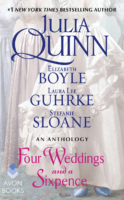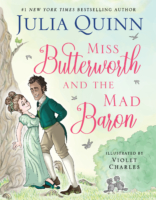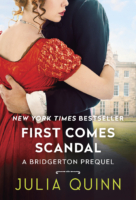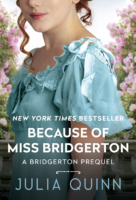Inside the Story
There is always more to the story — the story of writing the book, that is. For each book I gather a few interesting tidbits, sometimes some images, even a few videos. These appear on each book page, but I've also gathered them all here, too.
Unboxing Romancing Mr. Bridgerton
Inside Four Weddings and a Sixpence
JQ’s Author Notes for this anthology is coming soon. Make sure you sign up for JuliaQuinn.com News for updates on newly posted content like what’s coming to this space.
Inside Queen Charlotte: A Bridgerton Story
- In January 2022 Shonda Rhimes called me with the news that Netflix had greenlit a Bridgerton prequel series about Queen Charlotte. A couple of months later, at the Bridgerton Season 2 premiere (literally backstage at the red carpet!) I suggested to Shonda that I write a novel based on the show. It turns out she had been thinking the same thing, and that was the beginning of Queen Charlotte, the novel.

- The collaboration process was one of taking turns. Shonda wrote six scripts and then gave them to me to craft into a novel. I did a bit of research on how to adapt scripts into a novel, and found absolutely nothing. It turns out there haven’t been too many novelizations of television shows or movies–at least not the way Shonda and I envisioned it. We wanted Queen Charlotte, the novel, to read like a fully-formed novel, like something that could stand on its own even if you didn’t watch the show. I realized that I was going to have to figure out the process on my own. I remember turning to my husband and saying, “Well, people might say I did it badly, but no one can say I did it wrong.” In the end, I had to break down the architecture of a screenplay and then rebuild it as a novel. I honestly don’t know how else to describe it. It was a fascinating process, and one I enjoyed immensely.
- The biggest change between the show and the book was the elimination of the later storyline, with the characters we know and love from Netflix’s Bridgerton. I simply didn’t see how jumping back and forth —which works so well in a television format— was going to work for a novel, especially since I wanted the book to have as much of a romance novel feel as I could. It was never going to be a true romance novel; the ending is far too bittersweet to be a classic HEA. But I wanted Charlotte and George’s courtship to read like a romance novel. I wanted readers to have all the same heady feelings we get when we watch a couple fall in love. This would be difficult to achieve, however, if we kept moving back into the later timeline, when George is so diminished.
- I’ve never been a visual writer, and thus I don’t usually have a clear (or even a fuzzy) picture of my character’s faces when I write my novels. While writing Queen Charlotte, however, I visited the set, met the actors, and then later watched early cuts of the show. It was an entirely new experience for me to be able to see (and hear!) the characters so clearly as I was writing the novel. I loved being able to incorporate bits and pieces of the actors’ performances. For example, Corey Mylchreest bites his lip when he (George) is amused. So when Charlotte is realizing the depth of her affections for George she thinks: “She looked up at him, at his beloved face, those dark brows, and the full lower lip he liked to bite when he was amused.”
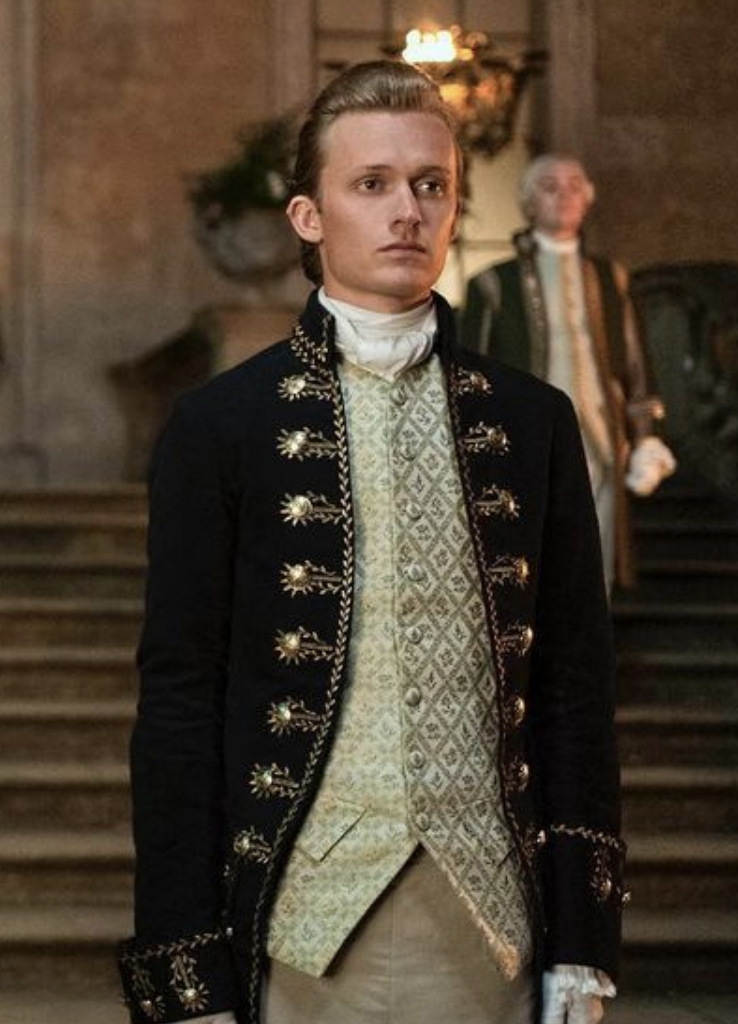
Freddie Dennis as Reynolds in Queen Charlotte. Photo: Netflix I had a similar experience after meeting Freddie Dennis, who plays Reynolds. From the scripts, I knew that Reynolds was tall, handsome and self-composed, but I had not realized how regal Freddie played him. Reynolds may be a servant, but he has an almost aristocratic demeanor, and this became a big part of his characterization in the novel.

- Shonda and I (and our publisher) know that some readers don’t like tie-in covers featuring actors, so the original idea was to release the Queen Charlotte hardback edition with two different covers — one with India Amarteifio and Corey Mylchreest as Charlotte and George, and another that looked more like a “regular” book. But when HC’s marketing director suggested that we go with a reversible cover, we knew we had our answer — everybody would get BOTH covers. I think it turned out amazing, don’t you?
Find out more about the reversible cover→
*please note: the trade paperback edition comes with tie-in cover only.
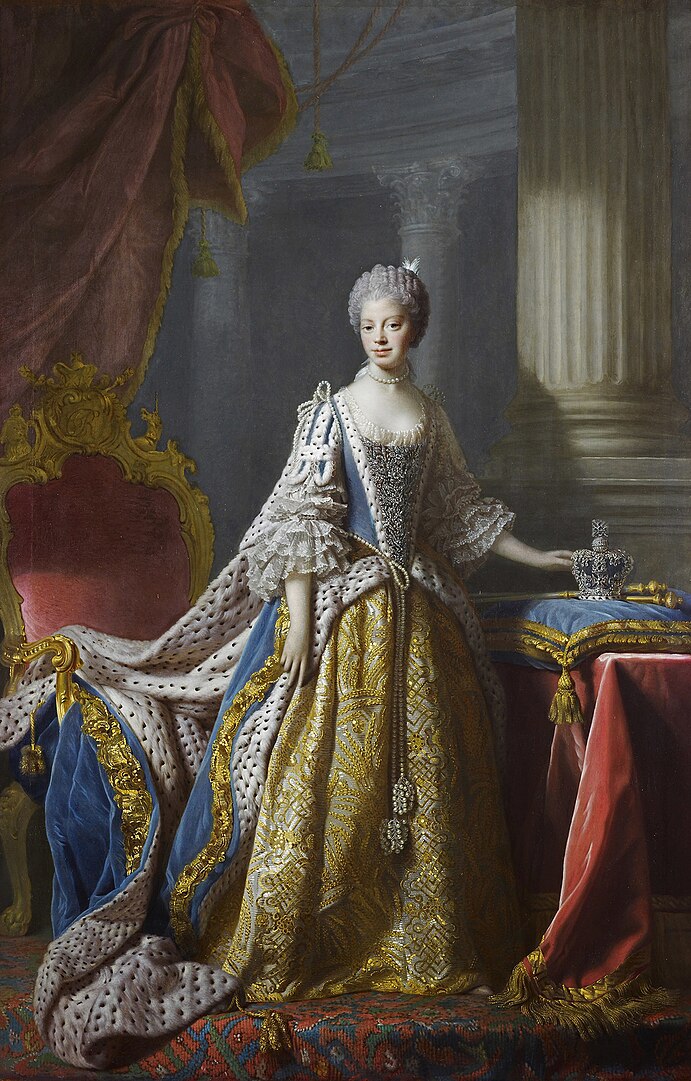
- The real Charlotte of Mecklenburg-Strelitz did not speak a word of English when she arrived in London. She and George were able to communicate using a combination of German and French. (I tend to think it was mostly German; although George was the first British monarch from the house of Hanover to speak English as his mother tongue, his parents’ first language was German, and he was undoubtedly fluent.) The Netflix show does not delve into Charlotte’s language barrier, and in truth, the novel doesn’t, either, but I thought it would be fun to at least acknowledge Charlotte’s mother tongue, especially since I adore long German words. So Charlotte frequently expresses frustration that she can’t simply mash up words and make new ones, as it seems the Germans often do. In one of my favorite moments, George reminds her that she is Queen and can do whatever she wishes.
- King George was indeed an avid scholar of science, and many of his scientific instruments can be seen at The Science Museum in London. I visited the museum in July 2022 to see them for myself and highly recommend a visit if you’re in the UK.The Transit of Venusis a very real astronomical phenomenon. It occurs when the planet Venus travels directly between the sun and the Earth and can be seen from Earth as a small black dot traveling across the sun. Transits of Venus occur in a “pair of pairs” pattern, occurring approximately every 243 years. First two transits take place in December, eight years apart. Then, after 121.5 years, we get two June transits, again 8 years apart. After 105.5 years, the pattern repeats. Thus the most recent transits have occurred: December 8, 1874, December 6, 1882, June 8, 2004, June 5-6, 2012. Then next two transits will be: December 10-11, 2117, December 8, 2125. George was indeed fortunate to be alive for two transits!

- We don’t know —and likely will never know— the cause of George’s mental illness. It may have been a psychiatric disease, or it could have been a brain tumor that affected his faculties. It has also been suggested that he suffered from porphyria, which is a liver disorder that can present with psychiatric symptoms. Indeed, the 1994 film The Madness of King George, presents porphyria as the cause of George’s dementia.The historical record suggests that he did not start showing signs of decline until his late 40s or early 50s; it’s unlikely that he would have had an episode such as the one depicted in Queen Charlotte so early in his marriage. We have very much taken poetic license with this. What is real, though, is the King and Queen’s true love and devotion to one another. This is well-documented and is considered one of the greatest love stories of the British Royal Family.
![]()
Inside Miss Butterworth and the Mad Baron
- Miss Butterworth and the Mad Baron (the fictional gothic novel, not the very real graphic novel) appears in six of my books: It’s in His Kiss, What Happens in London, Ten Things I Love About You, Just Like Heaven, The Sum of All Kisses and The Secrets of Sir Richard Kenworthy. It’s a very badly written, over-the-top gothic novel that half of my characters love and and half of my characters think is utter drivel.
 When readers asked me to write Miss Butterworth and the Mad Baron, I always said no. The writing is florid, the plot absurd—It’s a lot of fun in bits and pieces, but an entire book would not be a pleasurable reading (or writing) experience. But my sister Violet Charles was a cartoonist and illustrator, and it occurred to me that while it would be a terrible prose novel, it could be a spectacular graphic novel. I gave her the idea, and she ran with it.
When readers asked me to write Miss Butterworth and the Mad Baron, I always said no. The writing is florid, the plot absurd—It’s a lot of fun in bits and pieces, but an entire book would not be a pleasurable reading (or writing) experience. But my sister Violet Charles was a cartoonist and illustrator, and it occurred to me that while it would be a terrible prose novel, it could be a spectacular graphic novel. I gave her the idea, and she ran with it.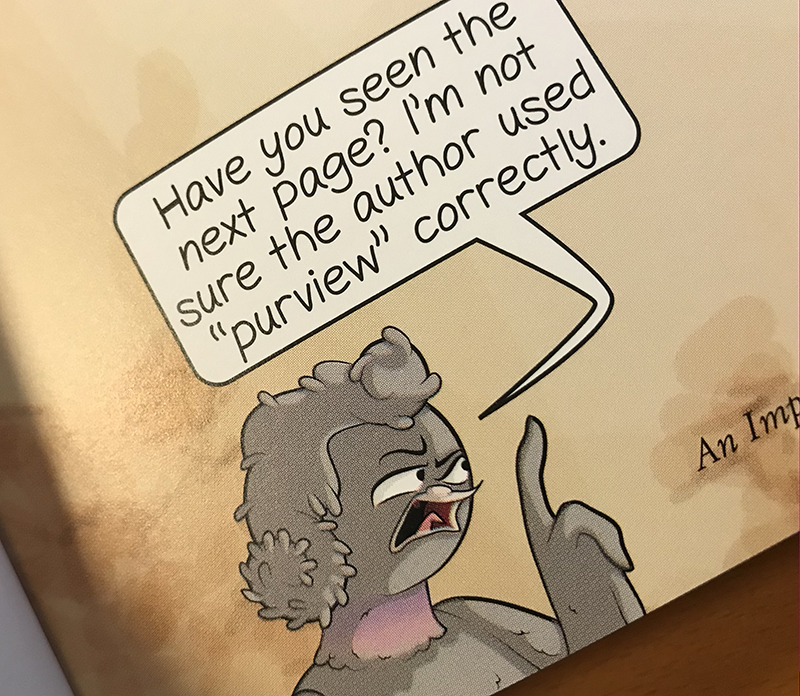 On the interior title page, one pigeon says to the other, “I’m not sure the author used ‘purview’ correctly.” This is a nod toward What Happens in London. Olivia says this to Harry, who says it to Prince Alexei, who says it Sebastian, who (predictably) says, “Of course it is.”
On the interior title page, one pigeon says to the other, “I’m not sure the author used ‘purview’ correctly.” This is a nod toward What Happens in London. Olivia says this to Harry, who says it to Prince Alexei, who says it Sebastian, who (predictably) says, “Of course it is.”- The pigeons have names, even though the reader doesn’t learn them all. We made magnets out of them (below). Left to right, they are: Sylvia Van Nest, Jean-Clawd, Clarence, Wingston, Rebeaka, and Eggsmerelda. Not pictured: the Propriety Pigeon. And Gerald.


Inside Wit and Wisdom
Inside First Comes Scandal
- Edinburgh Medical School did not admit women until 1869 when Sophia Jex-Blake, Emily Bovell, Matilda Chaplin, Helen Evens, Mary Anderson Marshall, Edith Pechey, and Isabel Thorne matriculated. They became known as the Edinburgh Seven and were, in fact, the first women to matriculate at any British university.
From the University of Edinburgh website:“Their classes, which were taken separately, were graded differently to the men even though the lectures were identical, resulting in diminished scholarship opportunities. The everyday jealousy the male students exhibited was vile. The men made life as difficult as possible for the Edinburgh Seven, shutting doors in their faces, howling at them and behaving aggressively. Events came to a head at their anatomy exam, when several hundred male students pelted the women with mud and other objects as they arrived. The women struggled through the crowd until a supporter unbolted a door to hurry them inside. During the exam the rioters shoved a live sheep into the hall, causing further chaos.”
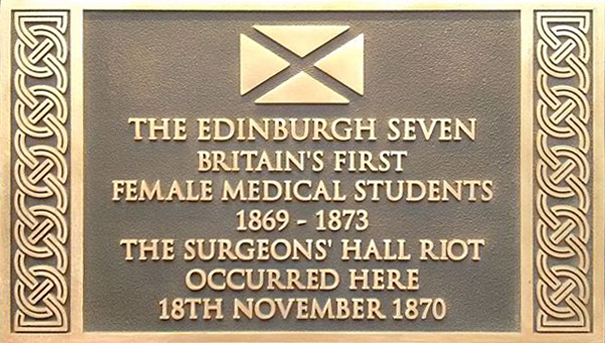
Public domain as per Wikimedia Commons. In 1873, however, the university ruled that it should never have admitted the women in the first place and declined to grant them diplomas, despite the fact that they had studied for four years. The University of Edinburgh did now allow women to graduate with any sort of degree until 1894. The first women doctors graduated in 1896. And in 2019, on the 150th anniversary of the matriculation of the Edinburgh Seven, the University of Edinburgh granted honorary degrees to all seven women.
- The Dr. Monro who was giving the medical lecture at the end of the book was Alexander Monro, a noted Scottish physician, anatomist, and medical educator. He was but one of three Alexander Monros, the other two being his father and son. Together, these three generations of Monros held the Edinburgh University Chair of Anatomy for 126 consecutive years. Although it is impossible to know how Dr. Monro might have treated an asthmatic attack in the late 18th century, my research indicates that bloodletting would have been a likely course of action.
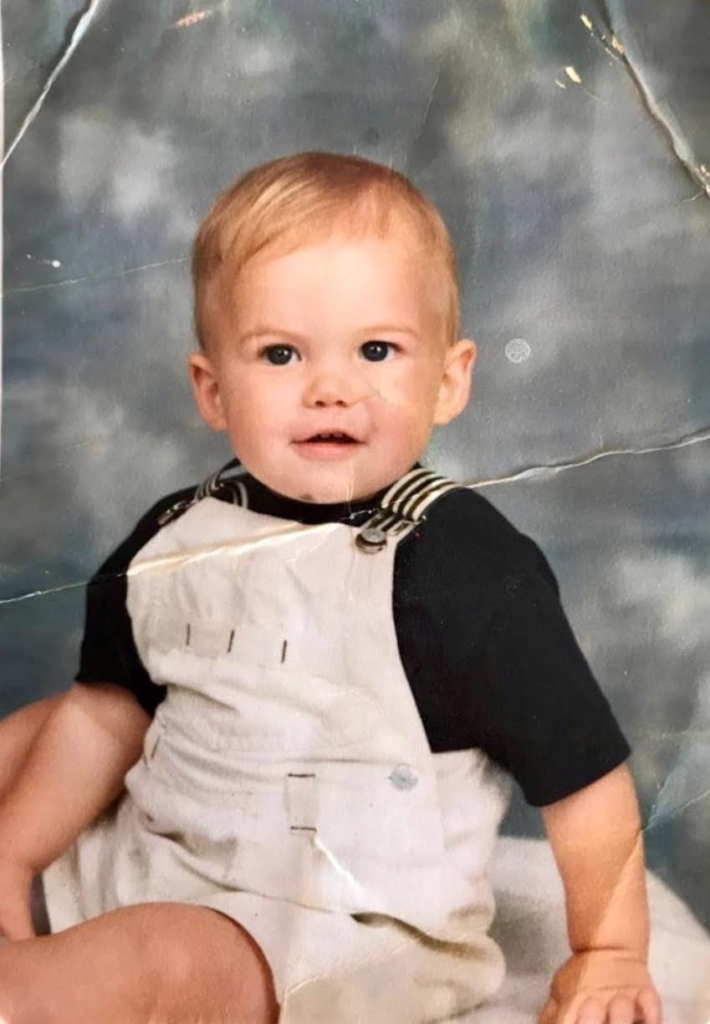
- I’m not a very visual writer, and I rarely have a clear picture of my characters’ faces as I’m writing. But when I got to the scenes with young Anthony, Benedict, and Colin, I realized that the situation was a little different. Filming was already underway for the Netflix series Bridgerton, which stars Jonathan Bailey, Luke Thompson, and Luke Newton as the adult versions of the Bridgerton brothers A, B, and C. So I kind of did know what they looked like. I asked Luke Newton for a baby pic, and he immediately replied, “I’ll ask my Mum.” Just a few hours later I received a photo of a very chubby-cheeked Luke N. I took one look and thought, “That’s Baby Colin!”
- Cat-Head’s name comes from a cat that lived across the street from me many years ago in Denver. I just thought it was the funniest name. Cat-Head’s hideous moaning, however, is entirely based on my sister’s cat Margaret. I have never in my life met a noisier cat–In volume, in frequency, or in atonality. And she never stops. I honestly don’t think my sister has had a decent night’s sleep in the last five years.
- The carriage journey to Edinburgh is dedicated to every single person who has ever had to travel with a cat. When I was writing the scenes, it occurred to me that if cats hate being in cars so much, they probably also hate riding in carriages.
Inside The Other Miss Bridgerton
- If you’ve read The Girl With the Make Believe Husband (Book 2 in the Rokesby series) you know that it ended with Edward Rokesby asking about his brother Andrew. To which George Rokesby replies, “Well, now that is quite a story.” This is where I admit that I had NO IDEA what that story might be. I figured—Andrew is such a fun character, surely he’s up to something romance novel-worthy. I eventually cooked up a plot in which he was sent to the central European principality of Wachtenberg-Molstein (don’t try to locate it on a map; I made it up). His job was to escort a princess back to London. He wasn’t going to fall in love with the princess, though; he was destined for her more sensible (and less likely to cause a diplomatic incident) only semi-royal cousin. At least that was the plan. All this, and I had the added bonus of being able to gather research on a Danube river cruise I took with my niece. Score!
- Alas, the story went nowhere. I don’t think I even made it out of Chapter Two. I finally gave up and started afresh, but I was so annoyed that I decided Andrew would still have to go to Wachtenberg-Molstein. And indeed, you’ll find mention of it—and his eventful journey home—within the pages of The Other Miss Bridgerton.
- In 1755 Lisbon was hit by a devastating earthquake, the magnitude of which is now estimated between 8.5 and 9 on the Richter scale. Three tsunamis and a fire followed, and by the time the it was all over, 85% of Lisbon’s buildings had been destroyed. The rebuilding effort commenced soon thereafter; barely a month after the quake, the king and prime minister had approved a plan to raze the Baixa quarter and “lay out new streets without restraint.”
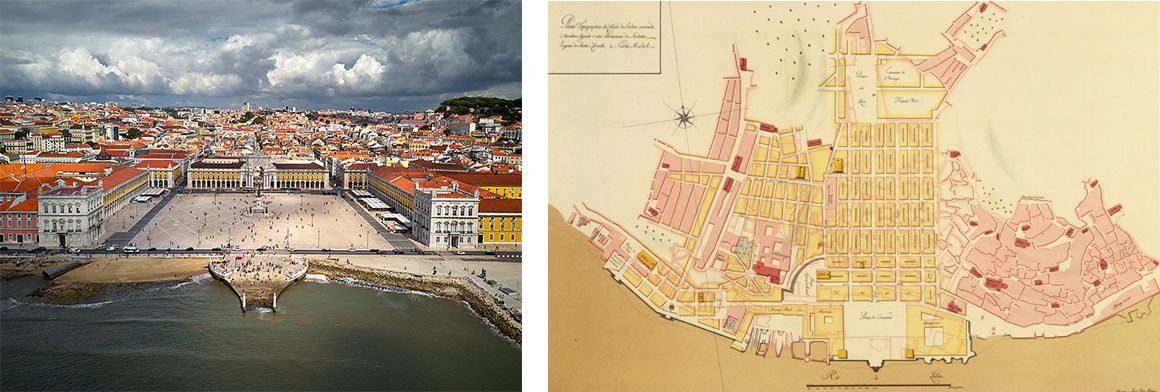
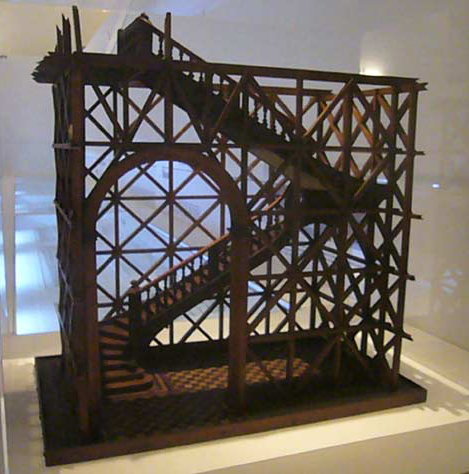
- This rebuilt neighborhood has endured, and its buildings are considered some of the earliest seismically protective architecture in Europe. Most buildings were built over framework known as Pombaline Cages (named for the first Marqês de Pombal, who led the reconstruction efforts). I knew that Andrew would be fascinated by the construction; one has only to look at his passion for building card houses to know that he’s an architect at heart.
- I discovered malasadas in Honolulu, of all places. While visiting with my sister, I decided we HAD to find a true local place to eat, and we ended up at Leonard’s Bakery, which was founded in 1952 by Leonard & Margaret Rego. Leonard was the grandson of Portuguese immigrants, and when he introduced the “Portuguese Doughnut” to Hawaii it was an instant hit.

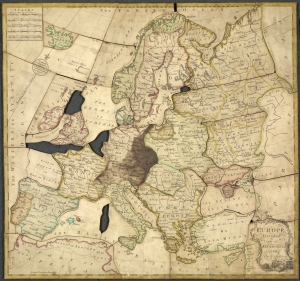
- I stumbled upon the idea of dissected maps when I was researching the history of jigsaw puzzles. (I can no longer remember why; maybe just because I love them myself.) There is some disagreement over who made the first one, but John Spilsbury, a London-based cartographer and engraver, was certainly among the earliest manufacturers. A map would be overlaid on thin wood, then cut along geopolitical boundaries with a handheld saw.
- The maps were very expensive and quickly became a symbol of wealth and privilege. Jane Austen alludes to this in Mansfield Park when Fanny Price is mocked by her wealthy cousin who says, “Dear mama, only think, my cousin cannot put the map of Europe together.”
- As far as I can tell, there were no dissected maps cut like Andrew’s—into many pieces, with no regard for geographical or political boundaries. Andrew’s puzzle would have been extremely expensive, but I think it’s exactly the sort of thing he’d choose to spend his hard-earned money on.

- When I was growing up, we put our Scrabble tiles in a purple and gold Crown Royal drawstring bag. I have no idea why; my parents are not big drinkers, and I’ve never seen either one of them drink Crown Royal. But the memory is strong, and so when I needed a bag for the puzzle pieces, I immediately pictured it as purple and gold.
- Finally, did you catch the brief mention of the Duchess of Wyndham? This is the same duchess who shows up much older (as the dowager duchess) in The Lost Duke of Wyndham and Mr. Cavendish, I Presume. Poppy is fairly certain that the duchess didn’t like her when they met, which seems exactly right, as the duchess we know doesn’t like anyone.
· Port of Lisbon street scene & map. Photo is licensed under the Creative Commons Attribution 2.0 Generic license. 1756 map is in the public domain.
· Pombaline Cage: Image is licensed under the Creative Commons Attribution-Share Alike 3.0 Unported license.
· Leonard’s Bakery image courtesy of leonardshawaii.com. Malasadas photo from Baking Bites review of Leonard’s.
· Dissected map: Image is licensed under the Creative Commons CC0 1.0 Universal Public Domain.
· Crown Royal bag: Image from the amazon.com listing.
Inside The Girl With the Make-Believe Husband
- I rarely model my characters after real people (in looks or personality) but I happened to be watching Poldark while I was writing the early chapters of The Girl With the Make-Believe Husband, and I was so struck by Eleanor Tomlinson’s eyes, that I decided to give them to Cecilia.
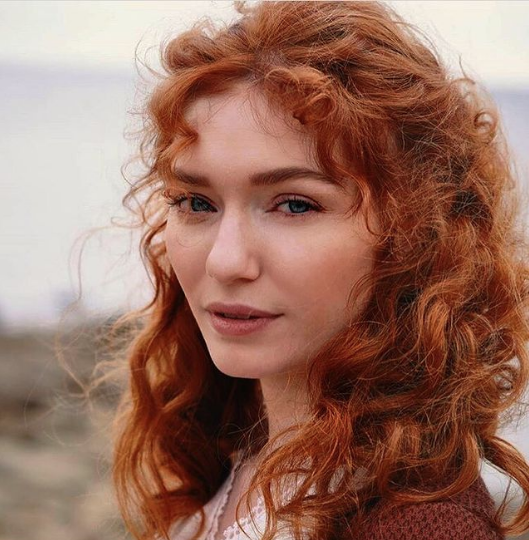
- Speculaas are spiced shortbread biscuits that were traditionally baked for St. Nicholas Day (December 5) in the Netherlands. They are thin, slightly brown, and crispy, and US air passengers might recognize them as the type of cookies given out on many flights under the Biscoff label. In recent years, Trader Joe’s has started using speculaas type cookies to make their now-famous Cookie Butter. TJ’s refers to the cookies as speculoos, which is the Flemish spelling of the word.

Images from Amazon for both Trader Joe’s Cookie Butter and Biscoff Cookies. - British forces occupied New York City for most of the Revolutionary War, and many prisoners of war were held on prison ships moored not far off the coast. These vessels were generally damaged or obsolete, and thus not useful in battle, and conditions on board were appalling. It is estimated that well over half the men held on these ships died during incarceration, most due to malnutrition or disease.
- One thing about Manhattan hasn’t changed over time: space is at a premium and real estate isn’t cheap. The British army, desperate to find room for all of its soldiers, commandeered countless buildings, including churches like the one used as a hospital in the early chapters of The Girl With the Make-Believe Husband.
- In Edward’s letter to Cecilia from Newport, Rhode Island, he mentions that some of his men were billeted in a synagogue. Although I didn’t mention it by name, this refers to Touro Synagogue, which is the oldest surviving Jewish synagogue in North America, and indeed, the only one that dates back to the Colonial era. Manhattan’s Congregation Shearith Israel, founded in 1654, is the oldest U.S. congregation, but its early buildings are no longer in existence and the current synagogue, on W. 70th Street, dates from 1897.

The Touro Synagogue in Newport, RI Interior. Photo credit: Stephan Savoia/Associated Press. 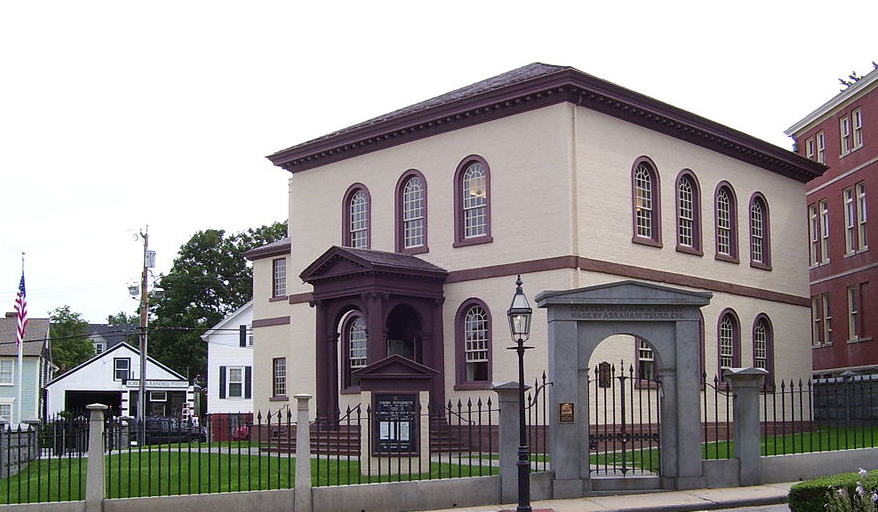
The Touro Synagogue in Newport, RI Exterior. Photo: Swampyank at Wikipedia. - Margaret Tryon was a real historical figure. She was born Margaret Wake, and when she married she brought with her a dowry of £30,000. Her father was the East India Company’s Governor of Bombay from 1742 to 1750, and her mother hailed from an old and influential Norfolk family. Indeed, it was through these connections that Margaret’s husband William Tryon secured his first major position in the New World, that of Lieutenant Governor of North Carolina in 1764. Margaret was thought to be an eccentric, and indeed a little “mannish,” due to her interest in military matters over more traditionally feminine pursuits.
- In 1773, the New York Governor’s Mansion burned to the ground, and the Tryons’ daughter (also named Margaret) was saved when her governess threw her out a second-story window into a snowbank. Ironically, Margaret Tryon (the younger) later died during a botched elopement in England when she fell from a ladder and impaled herself on a fence.
Inside Because of Miss Bridgerton
- I first got the idea of writing about an earlier generation of Bridgertons a few years after finishing On the Way to the Wedding, the final volume in the 8-book Bridgerton series. I knew I would never write a book about Edmund and Violet (the parents of the clan) but I thought it would be fun if they could appear as secondary characters during the time of their courtship. In the end, I decided to focus the series on the neighboring family (the Rokesbys), but the Bridgertons still loom large. Billie Bridgerton is seven years older than Edmund, though, so he is away at school during Because of Miss Bridgerton.
- I honestly don’t know if the Royal Navy would have sent an officer with a broken arm home to convalesce. But I figured that if they were going to let anyone have some sick leave, it would be the son of an earl like Andrew Rokesby.
- Aristocratic young ladies like Billie had to be presented at court before being introduced to society, and the dress code was both extravagant and strict. Even as silhouettes grew slimmer and hoops became less fashionable, ladies were required to wear wide panniers at their presentation. It was extremely difficult to move in these gowns, and ladies often had to turn sideways to fit through doorways. The gown in this photo is from the 1750s, but Billie would have worn something similar two decades later.

- I couldn’t resist bringing back Pall Mall, Bridgerton style, and it was fun to discover the origin of the Mallet of Death. It was pointed out to me later that in The Duke and I, it is claimed that Anthony Bridgerton coined the term, but I like to think that it’s one of those things that has entered family legend, and Anthony simply thinks he came up with it.
Inside Mr. Cavendish, I Presume
- For years I’d wanted to write a two-book set based on the premise: “Two men say they’re the Duke of Something. One of them must be wrong.” (Two points if you can guess where that line comes from.)
- The Lost Duke of Wyndham and Mr. Cavendish, I Presume take place concurrently, and their plots are very closely intertwined. When I began to develop these two novels, it became clear that if I didn’t want the plot or characters of one book to be dependent upon the other, I would need to write the two books simultaneously. Many scenes occur in both books, but from different points of view.
- As with The Lost Duke of Wyndham, the cover was meant to evoke a romantic movie poster. I got to pick out the cover models for this one!
- I have always been a total geek for maps, so I was very excited to be able to include some cartography in the book. The first map that Thomas and Amelia look at (the one in which Greenland looks so big) is a Mercator projection:

- Here is an example of a Mercator projection circa 1820:
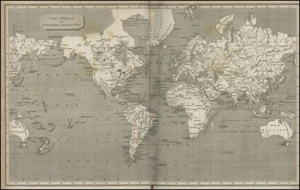
- And finally, here we have a cordiform projection. This world map (below) created in 1536 by Oronce Fine (1494–1555) who was one of the first French scholars to work with cartography.
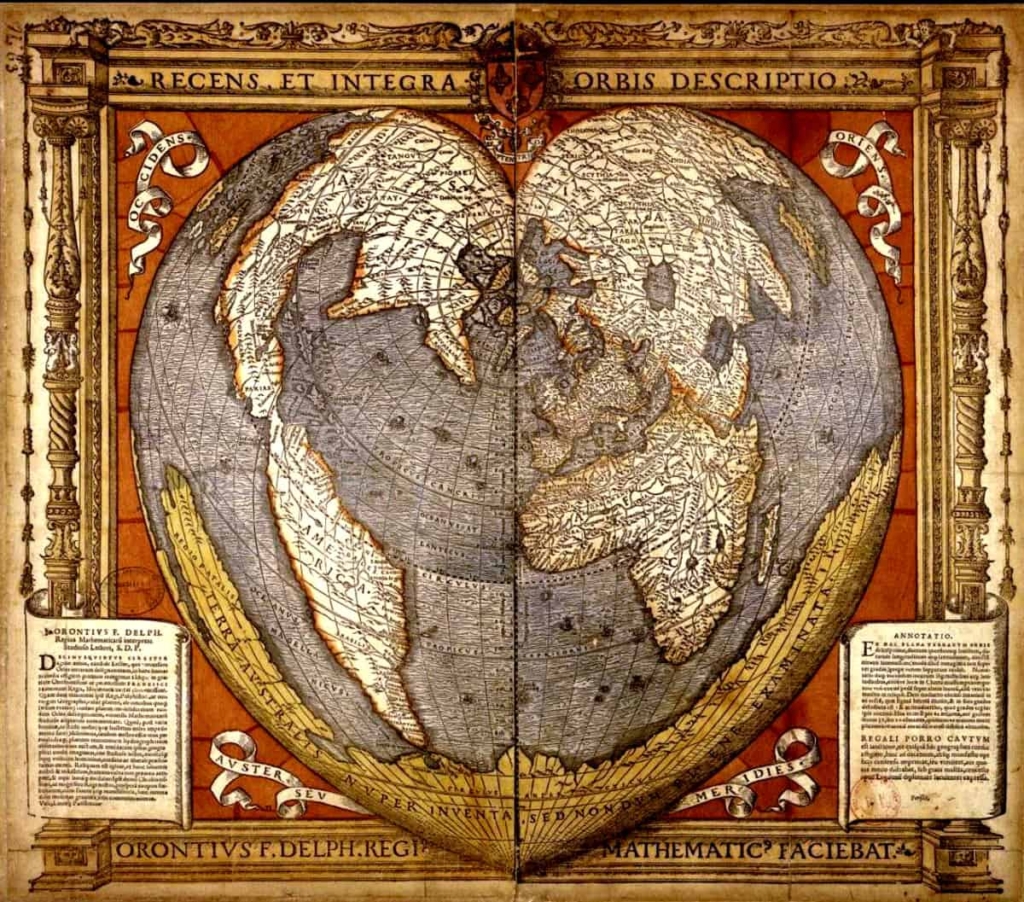
- I’ve loved the idea of the Outer Hebrides ever since I saw Barbra Streisand in What’s Up Doc? Wondering where they are?

